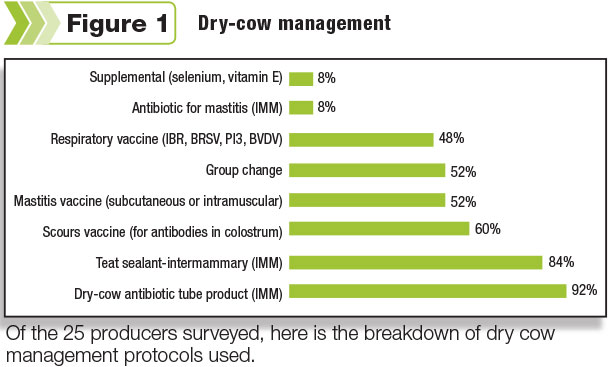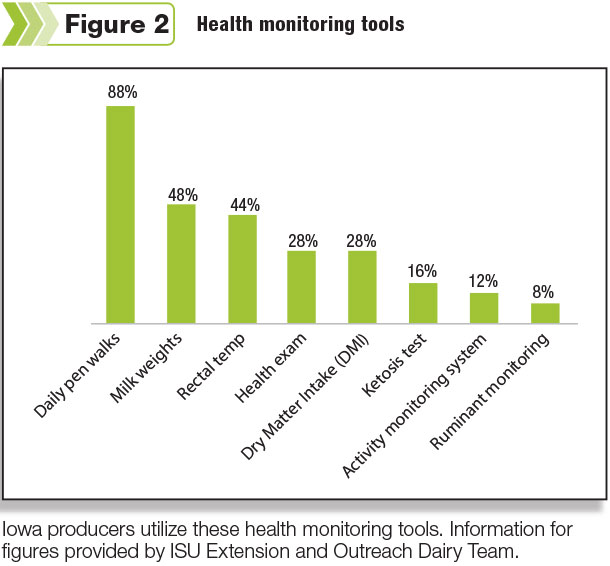The Iowa State University Extension and Outreach Dairy Team conducted a survey in 2015 of producers managing a transition cow program – defined as 60 days pre-calving to 30 days post-calving.
Twenty-five producers responded to the survey, managing predominantly conventional systems. Eight percent utilized a grazing system.
The herds averaged 395 milking cows (90 to 3,000) and 60 dry cows (10 to 450), with the predominant breed Holstein followed by crossbreds Jersey and Ayrshire.
Rolling herd average ranged from less than 20,000 pounds of milk (8 percent), 20,000 to 24,000 (20 percent), 24,000 to 28,000 (48 percent) and greater than 28,000 pounds of milk (24 percent). *Milking systems included parallel (40 percent), herringbone (32 percent), para-bone (32 percent) or robot (4 percent).
*Some may be milking in more than one milking system.
Thirty-six percent milk three times per day, while the robotic systems averaged 3.5 visits for the herd. Twelve percent doubled the milking frequency one to four weeks after freshening, with the robotic system milking fresh cows five-plus times per day.
Producers utilized one or more record systems, with 72 percent using PCDart, 60 percent using DHIA and 9 percent using DairyComp305. Eighty-four percent recorded fresh cow management such as disease, treatment and vaccination by writing it down on paper (52 percent), computer software (61 percent) or use of cellphone application. Seventy-six percent recorded calving difficulties.
Dry-off management

Dry-off practices were managed by the owner (72 percent), employee (20 percent) or a family member (8 percent). Cows were dried off on average 45 to 60 days pre-calving (79 percent) and fed a far-off dry cow ration (84 percent).
Prefresh management
The term prefresh was defined differently for producers, with 13 percent defining prefresh as day of calving, 25 percent defining it as two to three weeks pre-calving and 62 percent defining it as three to four weeks pre-calving. Seventy-two percent fed the prefresh group a separate ration.
Management practices for prefresh cows were conducted by the owner (68 percent), herdsman (20 percent), family member (8 percent) and employee (4 percent).
These practices included all herds giving a booster vaccine (salmonella, mastitis, scours), clipping of top lines in the spring (32 percent) and udder singeing (11 percent). Half of the farms raised heifers off-site and were brought back at varying ages pre-calving, with the majority coming back two to three weeks prior.
Day of calving
The final pen move prior to calving occurred at the first signs of calving (32 percent), when calving was imminent (16 percent) or when cows were moved three weeks prior to calving (36 percent).
Thirty-eight percent use a traditional and just-in-time calving strategy, with 25 percent using a socially stable strategy. Traditional calving was defined as cows moved from a dry cow group to a group maternity bedded pack within a few days of calving.
Just-in-time calving was defined as cows moved from a pre-fresh pen to an individual or group calving pen at the point of calving. Socially stable calving was defined as: managed pens kept together in the same group throughout the prefresh or entire dry period, typically in a series of bedded packs or a combination of freestall pens and a bedded pack for the final stage.
Owners were the most likely to manage the day of calving, with 60 percent taking charge. A herdsman or employee each managed the day in 24 percent of responses, while many used multiple people to assist.
The most common method of checking for calving was done by routine walk-throughs (88 percent), while 36 percent checked pens during milking times, and 16 percent of responders had cameras in the calving pens.
Time of calving assistance varied by producer one or more ways: always provided assistance at calving (4 percent), cow labored more than two hours (76 percent), assisted abnormal calving position (60 percent), minimal assistance or have Jerseys that tend to have a better calving ease than most breeds (12 percent) and no assistance (8 percent).
When asked how much force was used during assistance, producers estimated correctly at less than 500 pounds when hand-pulling. However, no one estimated correctly when using force with a calf jack, which is closer to 2,000 pounds of force used to pull the calf.
Postfresh management
Postfresh management was overseen by the owner (60 percent), herdsman (32 percent), family member (4 percent) or employee (4 percent). Sixty percent managed the postfresh cows in their own group for 14 to 30 days after calving, with 28 percent having a separate postfresh ration.
Postfresh cows were restrained less than a half-hour per day in 48 percent of responses, while 16 percent restrained cows for 30 minutes to an hour each day. Thirty-six percent didn’t use headlocks or cows were restrained in a chute as needed.
Up to 48 percent of producers have a written protocol for one or more treatments for milk fever, ketosis, metritis, retained placenta, displaced abomasum, off-feed and mastitis. However, only 12 percent have a written definition (written by the owner or veterinarian) for these diseases.
Predominantly, the owner (60 percent) makes the decision to treat an animal, with 16 percent being treated by a veterinarian and 24 percent treated by the herdsman. Half of the herds administer a respiratory and/or mastitis vaccine 30 to 60 days post-calving, while 32 percent are administered before 30 days and 9 percent after 60 days.
The voluntary waiting period ranged from 40 to 80 days, with one or more types of heat detection tools used to determine when to breed cows.
Producers were asked to select their top two reasons why cows left the herd in the first 60 days. They included:
- Disease or fresh cow problems (48 percent)
- Injury and illness (36 percent)
- Mastitis and udder (36 percent)
- Death loss (32 percent)
- Low production (16 percent)
- Lameness (8 percent)
- Sold for dairy (4 percent)
Fifty-two percent moved cows a total of three to four times from dry-off to 30 days postfresh, followed by 36 percent with one to two pen moves and 8 percent more than four pen moves. Thirty-three percent separated heifers from mature cows during the transition cow period.
Nutrition and feed delivery
Frequency of feed delivery varied between groups of transition cows. The majority fed far-off, prefresh and day-of-calving cows once per day, while 40 percent fed postfresh cows twice a day.

Cows fed the far-off dry ration never had feed pushed up in 44 percent of the herds, while prefresh, day-of-calving and postfresh had feed pushed up more than three times a day. An automatic feed pusher was used in one herd to push up feed multiple times a day.
There are many forages and supplements that can be added to the diet for each stage of the transition cow period. Many producers rely on their nutritionist to select products, hence the survey results are only what the producers knew about at the time of the survey.
If straw was used, an average of 5 pounds per cow was fed to the far-off dry cows, 4 pounds to the prefresh and day-of-calving, and less than 2 pounds per cow for the postfresh group. Thirty to 40 percent of the producers knew that Monensin and yeast was fed in some capacity with all stages of the transition cow diet.
Challenges
Challenges within the transition cow program for these producers can be categorized in four groups:
-
Nutrition: quality of feed, mixing correct amount of feed for size of group, finding low-potassium hay
-
Metabolic/disease: body condition score, retained placentas, frequency of twins, displaced abomasums, mastitis
-
Employee management: obtaining 100 percent compliance of protocols, maintaining consistency in transition program when the farm becomes busy in spring and fall
- Facilities: overcrowding, adequate space for calving, getting cows into the calving pen before calving, lack of postfresh group
Successes
Forty-two percent of producers would characterize their transition cow management as excellent, with successes for the transition cow program similar to the challenges. When they are working correctly, they can become major successes for the herd:
-
Nutrition: quality feed, low-potassium hay diet, high-forage milk cow ration, consistent feeding, free-choice dry hay at freshening, good body condition score
-
Facilities: smaller group and closer to the parlor, reducing overcrowding, fresh/clean bedding, facilities that allow for cow comfort and observation of cows, fewer pen moves, flexibility of barn for group sizes
-
Herd health: calving ease, timely vaccinations, post-fresh monitoring, Bovikalc
- Employee management: good care of fresh cows, excellent herdsman
Changes and economic impact
In the last five years, approximately 46 percent of producers have made impactful changes in the areas of far-off dry cows, prefresh, day-of-calving or postfresh. These changes include:
- Conversion to sand freestalls
- Building new or remodeled to house transition cows, allowing more room for cows
- Increasing the number of fans in the prefresh group
- Implementing a calcium bolus to the fresh cow program
- Installing headlocks for postfresh group
- Feeding Biochlor to postfresh group
Costs to make these changes ranged depending on the type of change, with facility changes ranging from $10,000 to $200,000.
Producers say making these changes has improved cow comfort and health, increased milk production and labor efficiency.
They were asked to provide their opinion on the economic impact of how transition cows were managed on their operation, with responses including: priceless, transition cows definitely make or break a dairy herd, 25 to 30 percent of their total lactation, $200 to $1,000 per cow difference.
Future plans
Future plans for producers surveyed included three areas:
-
Facilities: building a new transition cow barn, providing more space per cow with the addition of stalls or bedded-pack area, fans in the dry cow pen, changing from cross-ventilation to tunnel ventilation
-
Herd management: implementing an activity system, installing cameras in calving barn, hiring full- time employees for the transition cow barn
- Group of animals: separating first-calf heifers from mature cows, having a postfresh group, providing a close-up pen under a roof. PD
Transition Cow Management Surveys by ISU Extension and Outreach Dairy Team: Jennifer Bentley, Ryan Breuer, Larry Tranel, dairy field specialists in northeast/southeast/northwest Iowa; Ron Lenth; Bremer County director; and Leo Timms and Hugo Ramirez, state dairy specialists.
Funding for this project was provided by the North Central Risk Management Education Center and the USDA National Institute of Food and Agriculture. All resources pertaining to the Transition Cow Management Grant will be posted to: Iowa State University - extension and outreach extension store.

-
Jennifer Bentley
- Dairy Field Specialist
- Iowa State University - Extension and Outreach
- Email Jennifer Bentley




